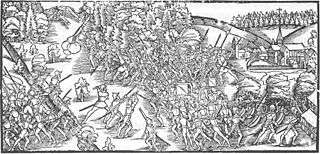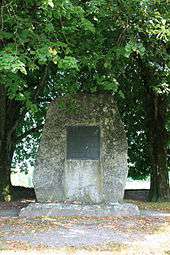Second War of Kappel
| Battle of Kappel | |||||||
|---|---|---|---|---|---|---|---|
| Part of Second war of Kappel | |||||||
 The forces of Zürich are defeated in the war (1548 etching) | |||||||
| |||||||
| Belligerents | |||||||
|
Catholics: |
Protestants: | ||||||
| Commanders and leaders | |||||||
| Hans Jauch | Huldrych Zwingli † | ||||||
| Strength | |||||||
| 7,000 | 2,000 | ||||||
| Casualties and losses | |||||||
| 500 | |||||||
The Second War of Kappel (Zweiter Kappelerkrieg) was an armed conflict in 1531 between the Protestant and the Roman Catholic cantons of the Old Swiss Confederacy during the Reformation in Switzerland.
Cause

The tensions between the two parties had not been resolved by the peace concluded after the First War of Kappel two years earlier, and provocations from both sides continued, fuelled in particular by the Augsburg Confession of 1530. Additionally, the Roman Catholic party accused Zürich of territorial ambitions.
As the Catholic cantons refused to help the Three Leagues (Drei Bünde) in the Grisons during the Musso war against the Duchy of Milan, Zürich promptly considered this a breach of contracts between the confederacy and the Three Leagues and declared an embargo against the five alpine Catholic cantons, in which Bern also participated.[1] While the Tagsatzung had successfully mediated in 1529, on this occasion the attempt failed, not least because Zwingli, the Protestant leader, was eager for a military confrontation. Pressed by the food embargo, the Catholic cantons declared war on Zürich on 9 October 1531.
Battle of Kappel

On 11 October 1531 a force of approximately 7,000 soldiers from the five Catholic cantons met an army of only 2,000 men from Zürich at the Battle of Kappel. Zürich's army was unsupported by the other Protestant cantons and was led by Zwingli, while the combined Catholic army was led by Hans Jauch of Uri. The main Zürich force arrived at the battlefield in scattered groups and exhausted from a forced march. The Catholic forces attacked and after a brief resistance, the Protestant army broke around 4 in the afternoon. About 500 Protestants were killed in the battle and while fleeing. Among the dead was Zwingli and twenty-four other pastors. Zwingli's body was taken by the victorious Catholic army and burned as a heretic.[2]
After the defeat, the forces of Zürich regrouped and attempted to occupy the Zugerberg, and some of them camped on the Gubel hill near Menzingen.[2]
Protestant response
Following the defeat at Kappel, Bern and other Reformed Cantons marched to rescue Zürich. Between 15–21 October, a large Reformed army marched up the Reuss valley to outside of Baar. At the same time, the Catholic army was now encamped on the slopes of the Zugerberg. The combined Zürich-Bern army attempted to send 5,000 men over Sihlbrugg and Menzingen to encircle the army on the Zugerberg. However, the Reformed army marched slowly due to poor discipline and looting. By the night of 23–24 October, they had only reached Gubel at Menzingen. That night they were attacked by a small Catholic force from Aegeri and driven off.[1] About 600 Protestant soldiers died in the attack and the panicked retreat that followed.[2]
This defeat destroyed much of the combined Zürich-Bern army and, faced with increasing desertion, it retreated on 3 November back down the Reuss to Bremgarten. The retreat left much of Lake Zürich and Zürich itself unprotected. Zürich now pushed for a rapid peace settlement.[2]
Aftermath
Heinrich Bullinger who had been a teacher at Kappel, and since 1523 an outspoken supporter of Zwingli's, at the time of the battle was pastor at Bremgarten. Following the Battle of Kappel, Bremgarten was re-catholicized. On 21 October, Bullinger fled to Zürich with his father, and on 9 December was declared Zwingli's successor.
The peace that ended the war, the so-called Zweiter Landfrieden (Second Territorial Peace) forced the dissolution of the Protestant alliance. It gave Catholicism the priority in the common territories, but allowed communes or parishes that had already converted to remain Protestant. Only strategically important places such as the Freiamt or those along the route from Schwyz to the Rhine valley at Sargans (and thus to the alpine passes in the Grisons) were forcibly re-catholicised. One result of the treaty—probably not anticipated by its signatories—was the long-term establishment of religious coexistence in several Swiss subject territories. In both the Thurgau and Aargau, for example, Catholic and Protestant congregations began worshiping in the same churches, which led to further tensions and conflicts throughout the sixteenth and seventeenth centuries. The treaty also confirmed each canton's right to practice either the Catholic or Reformed faith, thus defining the Swiss Confederation as a state with two religions,[1] a relative novelty in Western Europe. The outcome of the war also confirmed and cemented the Catholic majority among the thirteen full members of the Swiss Confederation: after later settlements in Glarus and Appenzell, seven full and two half cantons remained Catholic (Lucerne, Uri, Schwyz, Unterwalden, Zug, Fribourg, Solothurn, and half of Glarus and Appenzell), while four and two halves became firmly Swiss Reformed Protestant (Zurich, Bern, Basel, Schaffhausen, and half of Glarus and Appenzell).
An unsuccessful effort by the Protestant cantons, especially Zurich, to change the terms of confessional coexistence in 1656, the First War of Villmergen, led to a reaffirmation of the status quo in the Dritter Landfrieden (Third Territorial Peace). A second religious civil war in 1712, the Second War of Vilmergen, ended in a decisive Protestant victory and major revisions in the fourth Landfrieden of 1712.
See also
- First War of Kappel (1529)
- First War of Villmergen (1656)
- Toggenburg War or Second War of Villmergen (1712)
- Sonderbund War (1847)
References
- 1 2 3 Acton, Baron John Emerich Edward Dalberg (1903). A. W. WARD; G. W. PROTHERO; STANLEY LEATHES M.A., eds. The Cambridge modern history. Cambridge: University Press. Retrieved 12 January 2012.
- 1 2 3 4 Second War of Kappel in German, French and Italian in the online Historical Dictionary of Switzerland.
- W. Schaufelberger, Kappel - Die Hintergründe einer militärschen Katastrophe, in SAVk 51, 1955, 34-61.